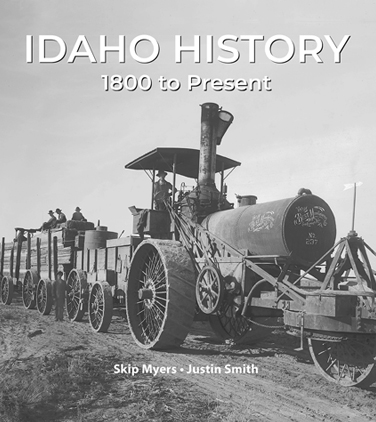1. What is it about the state of Idaho that is so fascinating to everyone who visits?
The most common thing we hear from visitors is, “We thought it was all just potatoes!” That’s pretty funny to most of us because the “famous potatoes” campaign was designed to boost agriculture, not to promote the state. The majority of Idaho consists of gorgeous mountain ranges and forests, dizzying canyons, and vast open steppe punctuated by lava flows. The state’s history is rich with mining, logging, political intrigue, farming, and Wild West stories that are better than the movies.
2. Why was it important for you to keep the Idaho Facebook group going?
It’s the top history group for our state and it’s an important resource for teachers, students, newcomers, and those citizens who may not have paid much attention in class. We strive for a high-quality page with a large number of photos and well-written posts to encourage people to learn in ways they may not have had the opportunity to do before. Idaho is truly unique and we want everyone to understand the factors that make it so distinct. History is essential to understanding why things are the way they are and our group is the only major source for many Idahoans to gain that knowledge.
3. The Idaho Facebook community has over 65,000 followers and is one of the most dynamic sites in Idaho. Why is this subject so fascinating to so many people?
Idaho’s history is clearly odd. I often think that the old Wild West movies and particularly the more humorous films like Paint Your Wagon or My Name is Trinity are a better representation of Idaho than of the desert southwest where many Western movies were filmed. The history of the Indian Wars, vigilantes, hold-ups, mining wars, railroad tycoons, brothels, religious differences, and all the rest truly happened right here and in an amazingly dramatic fashion. We have a lot of source material to draw from and people eat it up. There is always something new and fascinating to learn!
4. What surprised you most when you were researching this book?
That we could have easily written three of these books with the amount of material we had on hand. There is so much that happened that we were really struggling to decide what to add and what to leave for next time.
It was also surprising to see just how much Idaho’s geography decided how things happened. Idaho has a large region in the middle of the state that is nearly impassable because of the mountains and the Salmon River. That geographical oddity still influences much of Idaho today (there is only one north-south road between the two regions). Similarly, the Snake River Canyon in the southern part of the state defined communities and was a major obstacle for the Oregon Trail and early explorers. Idaho’s geology, topography and ecology are extremely diverse and that had (and has!) a major impact on how people lived their lives, built cities, and saw the world around them.
5. Where did you find the photos in this book? Was there one that particularly stood out to you?
The photos came from many sources including museum archives, private collections, and even postcards. However, we wanted to be careful to include photos that were compelling and likely something people had not seen before. That proved to be easier than we thought because of my background in the history of photography. We had some truly great photographers who worked in Idaho and being able to trace their work led us to many photos that were relatively unknown. Some photos were languishing in archives as far away as Europe. Others were found mislabeled in museum archives.
One of those photos is the one I am most proud of publishing. It was taken by noted Salt Lake City photographer C.R. Savage of the Eagle Rock railroad shops. Eagle Rock is now Idaho Falls and the railroad largely pulled out of the city very early on. The best photo of the shops that we knew had been published ad nauseum in nearly every book about Idaho history. However, finding the almost entirely unknown photo of the shops and with exquisite detail was a true highlight. Getting to share that image with the public was a privilege of which we are very proud. We knew we were publishing a coffee table book, but we still wanted it to contribute to the scholarship of Idaho history. We hope we accomplished both goals!



Follow Us!